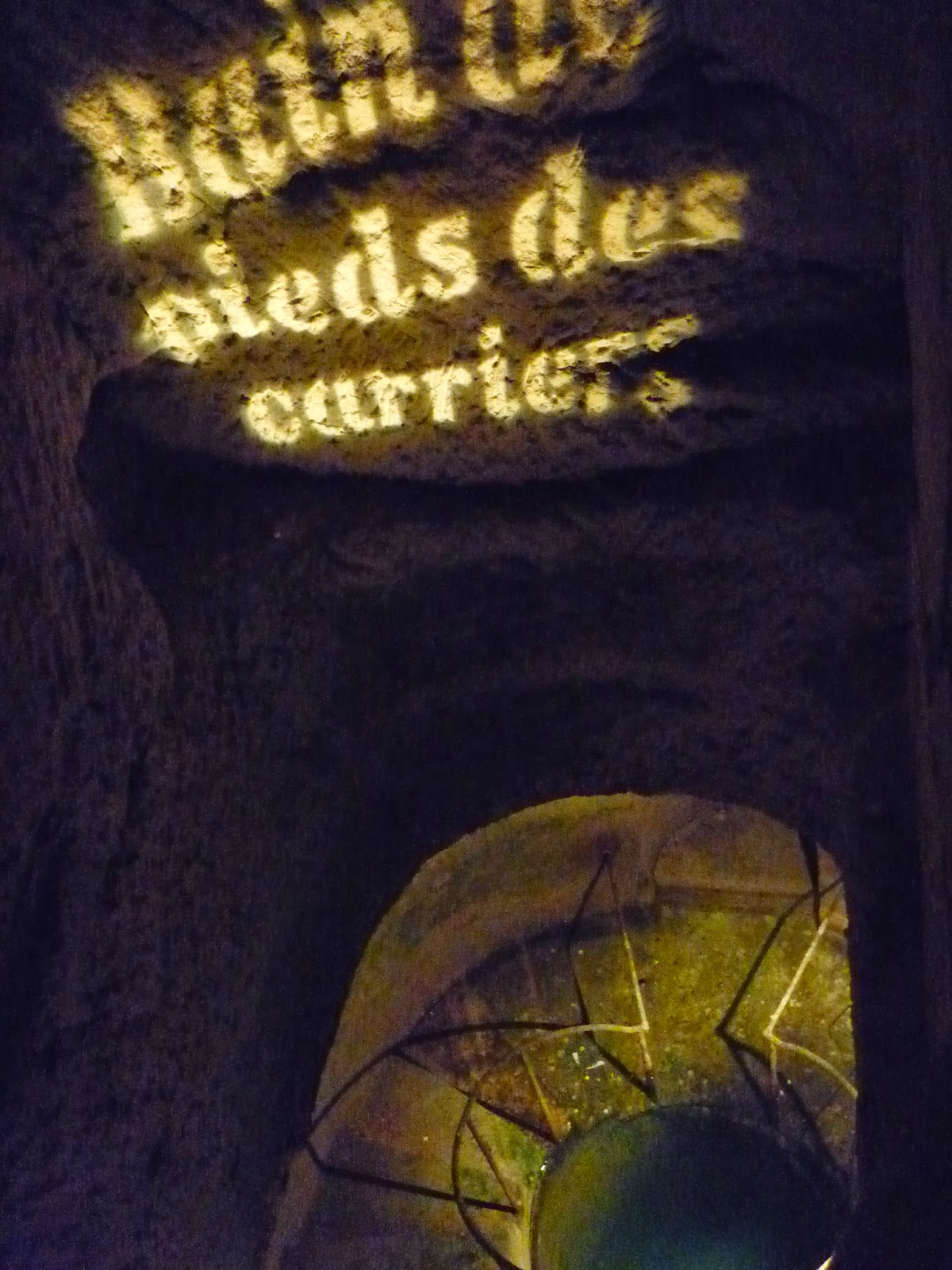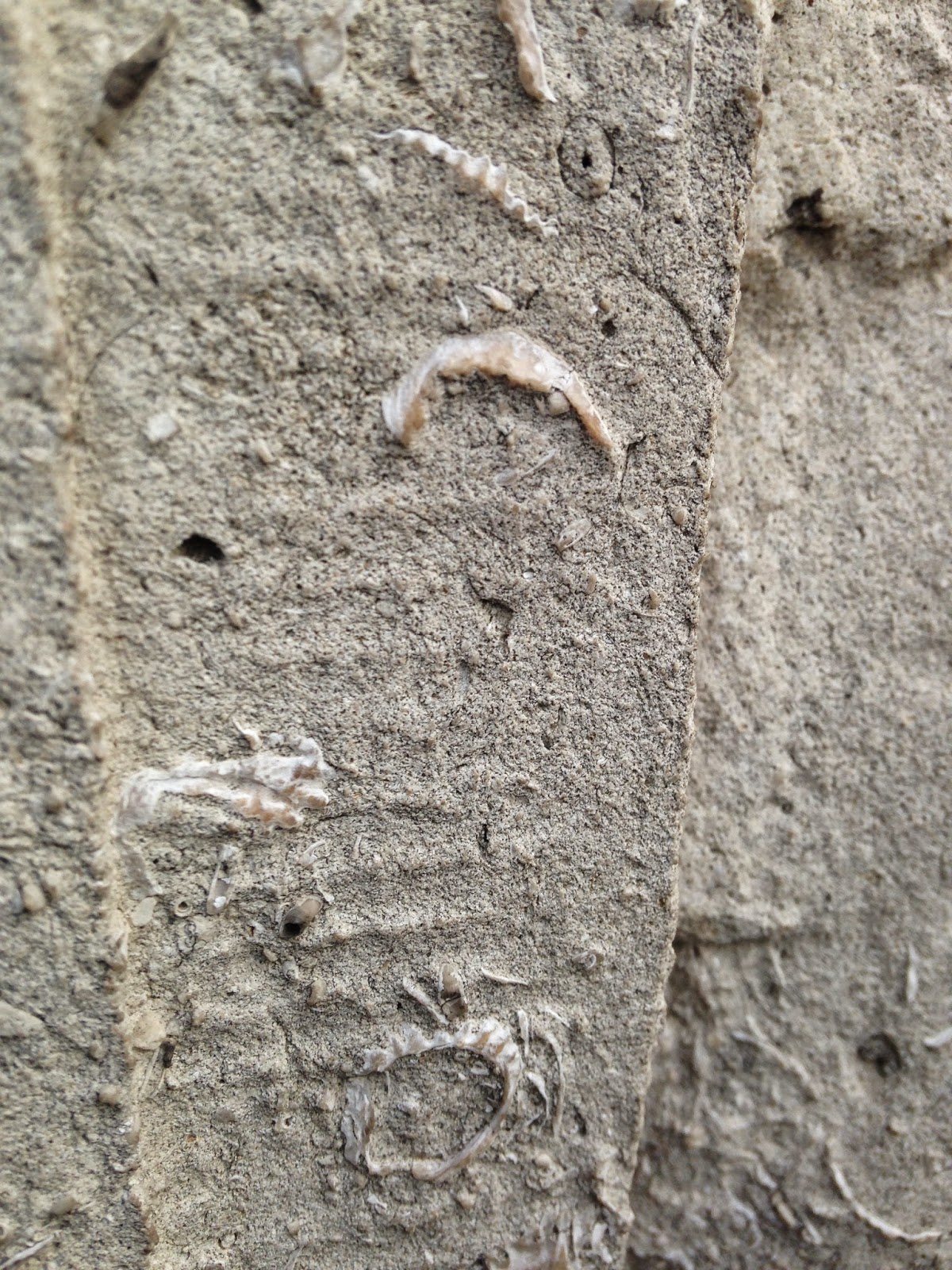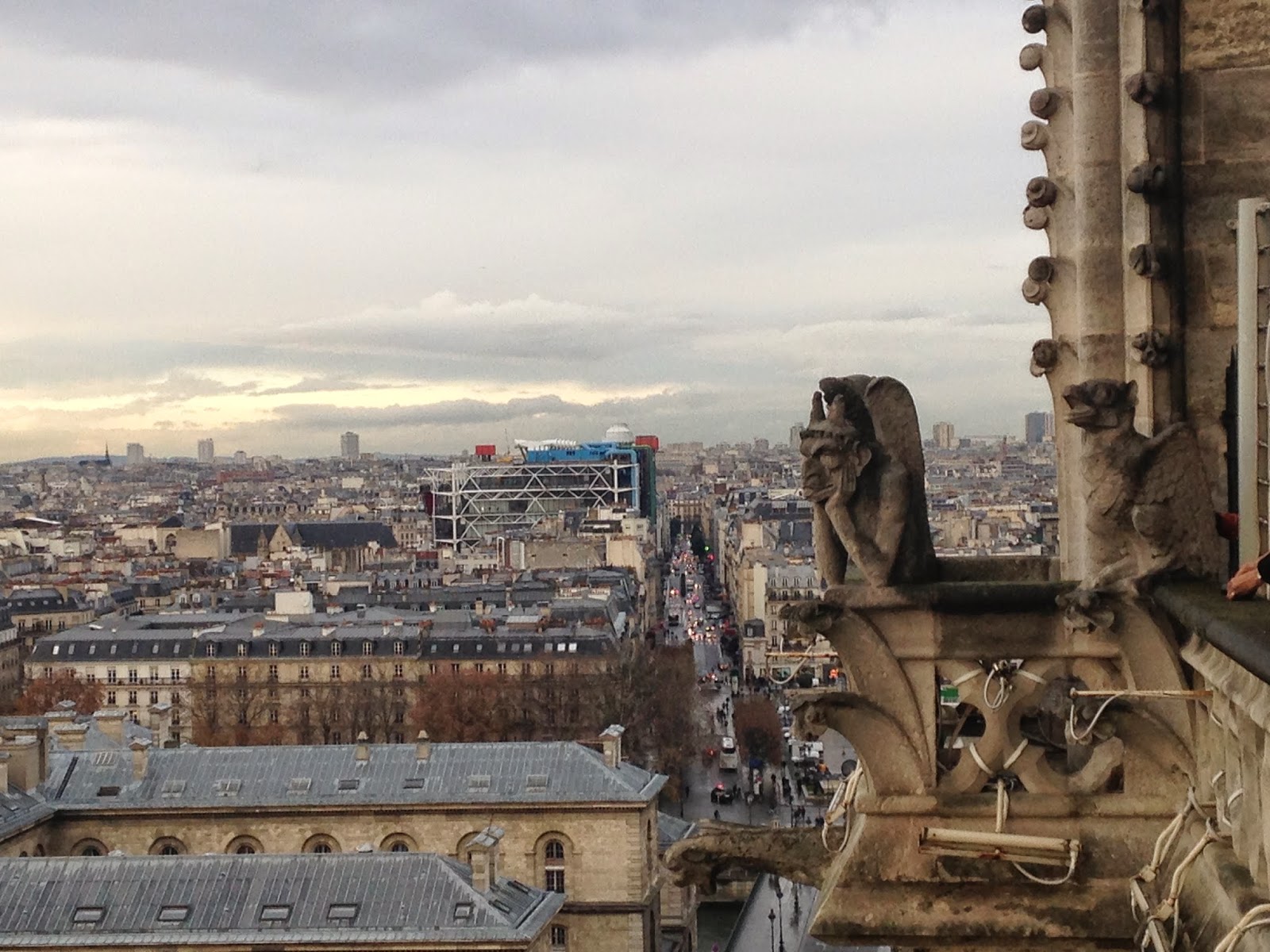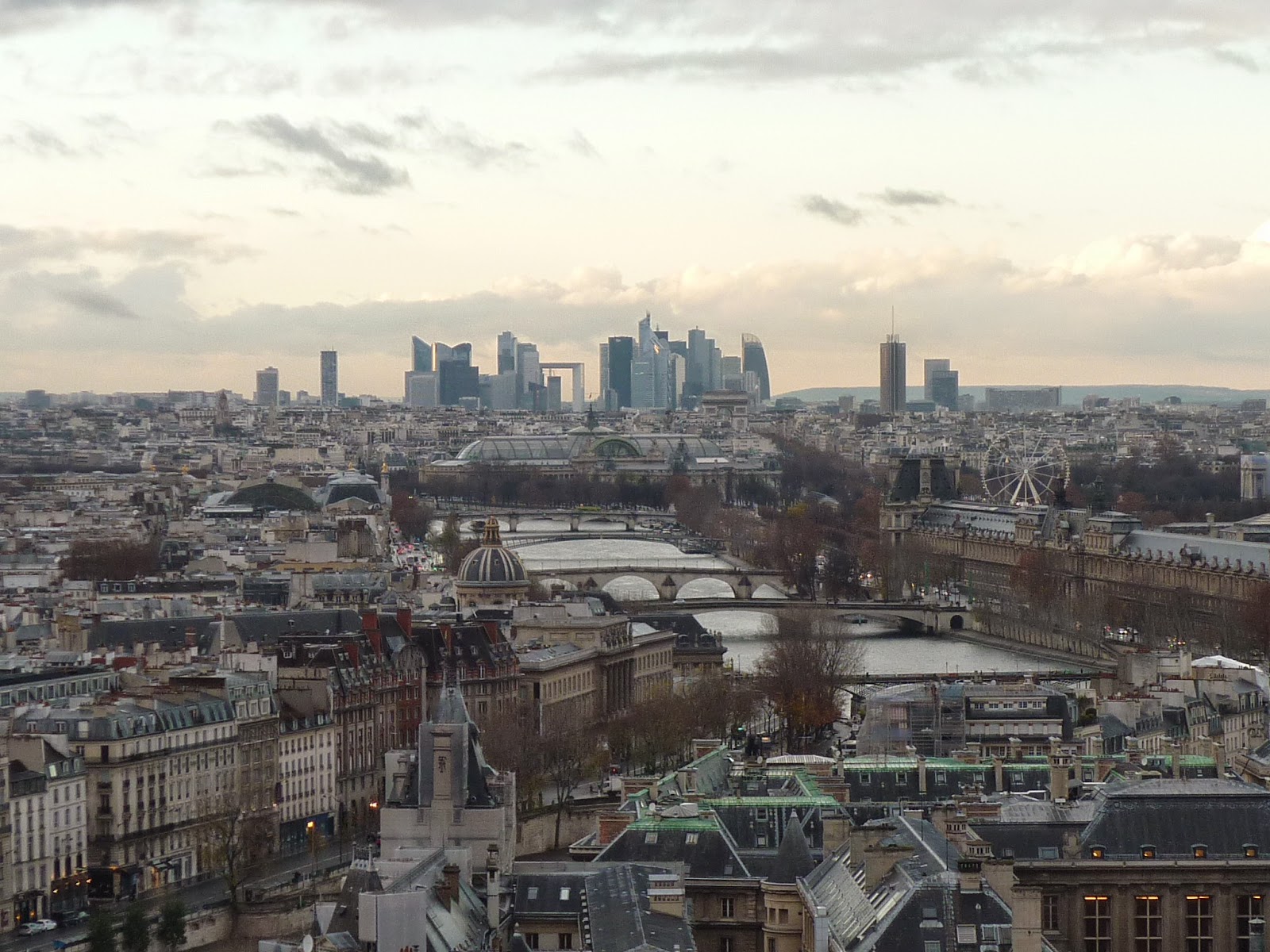Medieval History
Watching al-Hazen on Cosmos last night felt good. I'd studied him (via David Lindberg (oh my goodness, who just passed away) and his marvelous book, Theories of Vision: from al-Kindi to Kepler) and the kids loved the call for curiosity and questioning. It became another occasion to think about the endless, tumultuous combination of rational process and passionate accident (Tyson takes the time to see the happenstance and the waywardness of scientific inquiry), and the importance of scientific method, which somehow in our conversation became linked to civil discourse and Paris (again? always?). And so this morning, I'm underground, in the pell-mell space of the Catacombs - a space that is both freak show of the macabre in becoming an enormous ossuary in the 18th century and bedrock (yes!) of geoscience and the discovery of the geological period now known as Lutetian. But we'll be at the top of Notre-Dame by the end.
The time of the Catacombs is very queer indeed (she said, finally reading How Soon Is Now?), and loops back through human ambition, need, and curiosity. It was when sinkholes started swallowing buildings whole in Paris that Louis XVIth created the General Inspectorate of Paris Quarries. The year was 1777, and by 1813, the Inspectorate passed a decree forbidding any further quarrying under Paris. It turns out that roughly 1/10th of the city sits atop limestone quarries that had bountifully provided building materials throughout Roman antiquity and the Middle Ages. The amphitheater of Lutèce, as Paris was then known, was built of the stuff. Notre-Dame was built of it, as was the Château de Vincennes. The carving you see above was done in the living rock from 1777 to 1782 by a man named Décure, who was one of the first surveyors of the Inspectorate. He commemorated his imprisonment in the barracks of Port-Mahon by carving it out of the stone. That was one of the first responses to the re-appropriation and the re-discovery of this site, and it's one of the first things you see when you walk through the Catacombs. I wouldn't want to forget it, nor Décure, who died in a cave-in shortly after he completed his oeuvre. He was putting in a ladder to connect the Catacombs, some 28m below ground to the upper reaches.
 It was when they reached the bottom of the quarrymen's work that the geologists of the Inspectorate realized they were looking at something new. Seashells, tropical ones, line the quarrymen's marks in the rock. Lamarck came down and collected hundreds of fossils that added to his ideas of evolution (which went well beyond the theory of acquired characteristics for which he has been pushed aside for Darwin - another matter). A solid one hundred years later, the realization that this was a distinct geological period, one in which Paris had been awash in a salty sea, resulted in its naming: the Lutetian age, 48 to 40 million years ago, in the Eocene, that dawn of all eras. The part that resonates because it doesn't fit neatly is that the efforts of discovery and labor were simultaneous with the conversion of the quarries into an enormous ossuary to house the millions of remains which had accumulated in the Innocents and dozens of other urban cemeteries. Paris unearthed one era as it buried another. When the Catacombs were opened to visitors in the mid-19th-century - after all the bones had been arranged in patterns, and after citations about death and the afterlife from Virgil and other noble souls had been carved in plaques throughout - in those early days, geological specimens were on display in "cabinets minéralogiques" and you could marvel at and debate both human death and the geologic time.
It was when they reached the bottom of the quarrymen's work that the geologists of the Inspectorate realized they were looking at something new. Seashells, tropical ones, line the quarrymen's marks in the rock. Lamarck came down and collected hundreds of fossils that added to his ideas of evolution (which went well beyond the theory of acquired characteristics for which he has been pushed aside for Darwin - another matter). A solid one hundred years later, the realization that this was a distinct geological period, one in which Paris had been awash in a salty sea, resulted in its naming: the Lutetian age, 48 to 40 million years ago, in the Eocene, that dawn of all eras. The part that resonates because it doesn't fit neatly is that the efforts of discovery and labor were simultaneous with the conversion of the quarries into an enormous ossuary to house the millions of remains which had accumulated in the Innocents and dozens of other urban cemeteries. Paris unearthed one era as it buried another. When the Catacombs were opened to visitors in the mid-19th-century - after all the bones had been arranged in patterns, and after citations about death and the afterlife from Virgil and other noble souls had been carved in plaques throughout - in those early days, geological specimens were on display in "cabinets minéralogiques" and you could marvel at and debate both human death and the geologic time.
 Down in the Catacombs, you're not allowed to touch the bones (thank goodness), but you can touch the walls in certain places. When the Romans were here, these were above-ground quarries. As Paris built itself up from its own limestone (and increasingly that of nearby quarries at Yvelines), the quarries went underground, taking light and their fossils with them. I'm uncertain as to what their state was when Notre-Dame was built - probably a combination of contact points. I do know that the quarry tunnels that we walked during the Catacombs visits were probably carved out in the 15th century. And there are miles and miles of them. And so to touch that stone became to think on Paris under the sea, and Romans quarrying and Notre-Dame being built, and geologists looking closely, and sites of science and commemoration co-existing. And it made me wonder very much about whether or not Viollet-le-Duc went down there. And it made me wonder even more about his building materials for the restoration of Notre-Dame. He knew about the gorgeous, white Pierre de Saint-Leu limestone that comes from the Paris-area quarries (still found in the Catacombs and as far out as Yvelines) - he wrote about it in his Dictionaire. In his tenacious pursuit of authenticity, did he use the same limestone (I would think from another quarry, such as Yvelines) that the medieval builders he so loved used? I really had to ask myself these questions when I was up close with his restored gargoyles. I had started climbing the steps in homage to my advisor Michael Camille, who had a memorable picture of himself taken with one of Viollet-le-Duc's gargoyles. I wondered, too, then, what Michael must have thought of all of the little shells and crustaceans stuck in the bodies of the gargoyles. Is that a Lutetian close-up we're seeing in the image here? The temporal looping gets heady here: Viollet-le-Duc using the same stone for restoration as for the original building. Notre-Dame has then never been medieval as much as it has never been modern; even in its modernity/restoration it is made of stuff as ancient for us moderns as it was for the medievals. Our commonality with the Middle Ages is instantly created in the realization of the enormity of time that separates us both from the Lutetian period whence we have all carved and recarved our monuments.
Down in the Catacombs, you're not allowed to touch the bones (thank goodness), but you can touch the walls in certain places. When the Romans were here, these were above-ground quarries. As Paris built itself up from its own limestone (and increasingly that of nearby quarries at Yvelines), the quarries went underground, taking light and their fossils with them. I'm uncertain as to what their state was when Notre-Dame was built - probably a combination of contact points. I do know that the quarry tunnels that we walked during the Catacombs visits were probably carved out in the 15th century. And there are miles and miles of them. And so to touch that stone became to think on Paris under the sea, and Romans quarrying and Notre-Dame being built, and geologists looking closely, and sites of science and commemoration co-existing. And it made me wonder very much about whether or not Viollet-le-Duc went down there. And it made me wonder even more about his building materials for the restoration of Notre-Dame. He knew about the gorgeous, white Pierre de Saint-Leu limestone that comes from the Paris-area quarries (still found in the Catacombs and as far out as Yvelines) - he wrote about it in his Dictionaire. In his tenacious pursuit of authenticity, did he use the same limestone (I would think from another quarry, such as Yvelines) that the medieval builders he so loved used? I really had to ask myself these questions when I was up close with his restored gargoyles. I had started climbing the steps in homage to my advisor Michael Camille, who had a memorable picture of himself taken with one of Viollet-le-Duc's gargoyles. I wondered, too, then, what Michael must have thought of all of the little shells and crustaceans stuck in the bodies of the gargoyles. Is that a Lutetian close-up we're seeing in the image here? The temporal looping gets heady here: Viollet-le-Duc using the same stone for restoration as for the original building. Notre-Dame has then never been medieval as much as it has never been modern; even in its modernity/restoration it is made of stuff as ancient for us moderns as it was for the medievals. Our commonality with the Middle Ages is instantly created in the realization of the enormity of time that separates us both from the Lutetian period whence we have all carved and recarved our monuments.
 And so Paris, folding time through its constructions and reconstructions. Because this isn't just the juxtaposition of the old and the new, of Notre-Dame's gleaming Pierre de Saint-Leu limestone and the Pompidou's bright blue and red externalized tubing. It's the restoration of both buildings now; homages to materials that have long sustained the city, and which now/always need attention, need care. Viollet-le-Duc was on to something when he made his gargoyle contemplative.
And so Paris, folding time through its constructions and reconstructions. Because this isn't just the juxtaposition of the old and the new, of Notre-Dame's gleaming Pierre de Saint-Leu limestone and the Pompidou's bright blue and red externalized tubing. It's the restoration of both buildings now; homages to materials that have long sustained the city, and which now/always need attention, need care. Viollet-le-Duc was on to something when he made his gargoyle contemplative.
 Little could he have known that the gargoyle's gaze would today be turned to La Défense - the designated space for skyscrapers; where nary a wicker chair nor an accordion player, let alone Esmerelda and Quasimodo, are to be found; our neighborhood when we lived there. There's some kind of vector to be drawn between the gargoyle's ancient materiality and the projection of its gaze into Paris's image of its future self now. A complex geometry of curiosity and the desire to know in multiple times and dimensions.
Little could he have known that the gargoyle's gaze would today be turned to La Défense - the designated space for skyscrapers; where nary a wicker chair nor an accordion player, let alone Esmerelda and Quasimodo, are to be found; our neighborhood when we lived there. There's some kind of vector to be drawn between the gargoyle's ancient materiality and the projection of its gaze into Paris's image of its future self now. A complex geometry of curiosity and the desire to know in multiple times and dimensions.
- Daniel Hobbins Joins The University Of Notre Dame
Associate Professor Daniel Hobbins?s arrival at the University of Notre Dame this fall is a homecoming of sorts. A cultural and intellectual historian of the late middle ages, Hobbins received his Ph.D. in medieval history from Notre Dame?s Medieval...
- Margot Fassler Wins 2012 Otto Gründler Book Prize
Margot Fassler, Keough-Hesburgh Professor of Music History and Liturgy at the University of Notre Dame, was awarded the 2012 Otto Gründler Book Prize for her book The Virgin of Chartres: Making History Through Liturgy and the Arts. The prize was announced...
- Jerusalem Tomb Reveals First Archaeological Evidence Of Christianity From The Time Of Jesus
The archaeological examination by robotic camera of an intact first century tomb in Jerusalem has revealed a set of limestone Jewish ossuaries or ?bone boxes? that are engraved with a rare Greek inscription and a unique iconographic image that the scholars...
- Of "lithic Coils" And "petric Pregnancies" - _stone; An Ecology Of The Inhuman_ By Jeffrey Jerome Cohen
Fossils in Viollet-le-Duc's gargoyles of N-D ParisI've just closed the pages of Stone, an Ecology of the Inhuman, a book written (given, it feels) by Jeffrey Jerome Cohen. And so this isn't a review of the book, with measured time and thinking...
- Lincolnshire Churches - Building Materials
Theddlethorpe All Saints, Lincolnshire, originally uploaded by Vitrearum.Lincolnshire churches, particularly those in the Wolds and some parts of the marsh have a wonderful texture due to the wide range of materials used. Take this wall at Theddlethorpe...
Medieval History
The Lutetian Age, then and now and again
| In the very living rock |
The time of the Catacombs is very queer indeed (she said, finally reading How Soon Is Now?), and loops back through human ambition, need, and curiosity. It was when sinkholes started swallowing buildings whole in Paris that Louis XVIth created the General Inspectorate of Paris Quarries. The year was 1777, and by 1813, the Inspectorate passed a decree forbidding any further quarrying under Paris. It turns out that roughly 1/10th of the city sits atop limestone quarries that had bountifully provided building materials throughout Roman antiquity and the Middle Ages. The amphitheater of Lutèce, as Paris was then known, was built of the stuff. Notre-Dame was built of it, as was the Château de Vincennes. The carving you see above was done in the living rock from 1777 to 1782 by a man named Décure, who was one of the first surveyors of the Inspectorate. He commemorated his imprisonment in the barracks of Port-Mahon by carving it out of the stone. That was one of the first responses to the re-appropriation and the re-discovery of this site, and it's one of the first things you see when you walk through the Catacombs. I wouldn't want to forget it, nor Décure, who died in a cave-in shortly after he completed his oeuvre. He was putting in a ladder to connect the Catacombs, some 28m below ground to the upper reaches.
- Daniel Hobbins Joins The University Of Notre Dame
Associate Professor Daniel Hobbins?s arrival at the University of Notre Dame this fall is a homecoming of sorts. A cultural and intellectual historian of the late middle ages, Hobbins received his Ph.D. in medieval history from Notre Dame?s Medieval...
- Margot Fassler Wins 2012 Otto Gründler Book Prize
Margot Fassler, Keough-Hesburgh Professor of Music History and Liturgy at the University of Notre Dame, was awarded the 2012 Otto Gründler Book Prize for her book The Virgin of Chartres: Making History Through Liturgy and the Arts. The prize was announced...
- Jerusalem Tomb Reveals First Archaeological Evidence Of Christianity From The Time Of Jesus
The archaeological examination by robotic camera of an intact first century tomb in Jerusalem has revealed a set of limestone Jewish ossuaries or ?bone boxes? that are engraved with a rare Greek inscription and a unique iconographic image that the scholars...
- Of "lithic Coils" And "petric Pregnancies" - _stone; An Ecology Of The Inhuman_ By Jeffrey Jerome Cohen
Fossils in Viollet-le-Duc's gargoyles of N-D ParisI've just closed the pages of Stone, an Ecology of the Inhuman, a book written (given, it feels) by Jeffrey Jerome Cohen. And so this isn't a review of the book, with measured time and thinking...
- Lincolnshire Churches - Building Materials
Theddlethorpe All Saints, Lincolnshire, originally uploaded by Vitrearum.Lincolnshire churches, particularly those in the Wolds and some parts of the marsh have a wonderful texture due to the wide range of materials used. Take this wall at Theddlethorpe...
